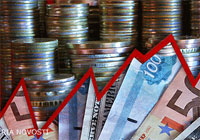Russian Economic Ministry expects economic growth slowdown to reverse in Q2

(Interfax – MOSCOW, May 16, 2013) The current trend of slowed economic growth in Russia might be reversed this quarter, according to the Russian Economic Development Ministry.
“We anticipate that there will be a turning point in negative trends already in the second quarter and that economic growth will surpass 3% in the second half of the year,” Economic Development Minister Andrei Belousov said at a government session dedicated to economic development scenarios for a three-year horizon.
This forecast takes account of an estimate of the effect of government economic growth stimulus measures.
Belousov recalled that the Economic Development Ministry warned at the end of last year that a pause in growth was likely in the first half of 2013 and that annual GDP growth might not surpass 3%.
“Unfortunately, the growth slowdown has been even stronger than we foresaw last year. GDP growth is slowing for the fifth quarter in a row, with values close to 5%, to 1.1% in the first quarter of this year,” he said.
There are two main groups of factors that have contributed to slowed economic growth.
“First, it’s the depressed mood of global markets. We haven’t had export growth in real terms for practically eight quarters, and exports saw a negative dynamic in the second quarter of last year, even in nominal terms,” Belousov said.
“Second are factors of the domestic monetary policy, primarily high interest rates. For loans to enterprises with a term of over one year, they were higher than 12% in the first quarter of this year. Combined with the ruble’s appreciation, that substantially reduces the competitiveness of Russian companies and suppresses economic activity,” the minister said.
Russia’s toughened monetary policy is supplemented by a rigidified budget policy, especially in terms of investment.
“Last year the decline in state capital investment was around 8% in real terms. This year roughly the same decline is expected,” Belousov said.
The Economic Development Minister noted that weakened state investment activity is supplemented by a drop in investments by the largest infrastructural companies, last year by 10%, and this year possibly by 12%-13%. “That’s predominantly in the gas industry,” he added.
Capex by infrastructural companies is responsible for almost 30% of investments into the Russian economy, so a 10% decline in their value means a deduction of roughly 3 percentage points from combined investments, he said.
“These trends have led to a reduction in the estimates of GDP growth for this year from the 3.7% that we expected last fall to 2.4%. But the economic dynamic would have to speed up markedly even to reach this reduced benchmark,” Belousov said.
Belousov’s ministry has already compiled an action plan to raise economic growth rates.
“Among these (steps) are measures to lower interest rates and raise loan affordability. According to our estimates, the average annual growth rate of loans to companies in 2013-2016 should be at least 16%-18%,” he said.
“We also believe that putting a limit on tariff growth for the services of infrastructural monopolies could provide a stimulating effect for the development of production,” the Economic Development Minister said. He added that these recommendations will be put together in August or September.
Furthermore, the ministry is discussing steps to improve the entrepreneurial climate, accelerate the implementation of the “national entrepreneurship initiative,” support exports and small business, raise the management efficiency at state-owned companies, and several others.
